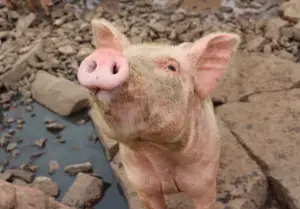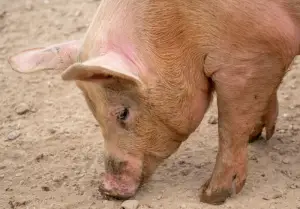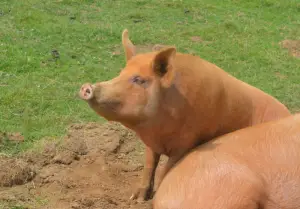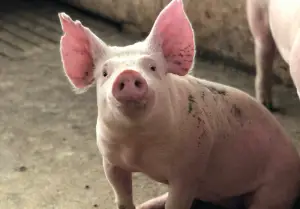Can Pigs Look Up?
Have you ever seen a pig staring up at the sky, daydreaming, and watching the clouds soar by? You probably haven’t – and not just because pigs have better things to do than stare at the sky (like eating and rolling around in the mud). There are anatomical reasons that you won’t see a pig looking straight up.
Can pigs look up to the sky? Technically yes, pigs can look at the sky – but not by staring straight upward. Pigs have unique anatomy, designed to make the most of rooting and foraging on the ground. Because of this design, pigs can only tilt their necks upward at about a 45-degree angle. Pigs can look upward, however, by tilting their heads, sitting on their haunches, and rolling on the ground.
Read on to learn more about the anatomy of the pig, why their spines have evolved this way, and how a pig can get around this obstacle to see the sky.
Pigs Struggle To Look Up Due To Their Anatomy
There are two anatomical reasons a pig’s upward vision is restricted. One reason is the way the spine has developed, and the other reason is because of the high percentage of fat around their necks.
The Pig’s Spine Prevents Looking Up
The process of natural selection is the force behind many of the unique attributes that various animals possess. Pigs are no different in the way that their spines and necks have evolved. A pig will spend the majority of its time looking at the ground in search of food, as its diet consists of roots, insects, worms, weeds, acorns, and carcasses. Pigs can spend their entire day staring at the ground.
A human would find it challenging and uncomfortable to hold his head in a downward position for hours on end. This is because our spines are not designed to support a head that is always facing the ground. A pig’s head can weigh around 15 pounds, and his spine has been designed to support a head that always has its nose to the ground.
The pig’s spine curves downward as it approaches the neck. The neck itself (or cranial vertebrae) will then point outward, parallel to the ground. From the neck, the natural position of the skull is pointed downward. All of these anatomical positions have evolved to meet the needs of the pig’s rooting nature.
The Pig’s Neck Fat Prevents It From Looking Up
Domestic farm pigs have evolved from wild boar and have been bred over thousands of years to gain a lot of weight in a short amount of time. This weight consists of both muscle and fat, and the fat is just as desirable as lean meat. Ask a group of people what their favorite pig product is, and the majority will probably answer “bacon”. Bacon comes from the fat of the pig and is highly sought after.
Along with the belly and the back, pigs carry a lot of fat on their necks. All of that fat can restrict the movement of the neck, and a pig will struggle to raise its head with pounds of fat on the back of the neck. Pigs with fattier necks will also have a more difficult time looking side to side and even in front of them.
There is a condition referred to as “fat blindness” that can afflict pigs when they gain too much weight. “Fat blindness” is what happens when a pig has gained so much fat on its face, that the fat rolls over the eyes. Pigs are made to gain fat – a lot of fat – and this can restrict the pig’s movement in a variety of different ways.
Pigs Can See The Sky, But They Have Limitations 
While the pig’s anatomy will prevent it from looking straight upward, this doesn’t mean that pigs cannot see the sky. There are a few different ways that pigs can see above them – from backing up and sitting down to tilting their heads and rolling on the ground.
If a pig would like to see up above, into the top of a tree, for example, he would simply back up so that the angle would not be as pronounced as if he were looking straight up. To look up even further, he would sit on his haunches.
Remember, the pig’s spine runs parallel to the ground and then slopes downward as it nears the neck. If a pig is sitting on his haunches, the spine will become angled, and the neutral position of the head will be tilted upward. From there, a pig can tilt upward even further, another 45 degrees.
Another way pigs see the sky regularly is simply by tilting their head. As humans, our eyes are located at the front of our faces. If we tilt our heads to the side, we are still looking in front of us, just at an angle. A pig’s eyes are located at the sides of its head, like a horse. Because of this location, when a pig tilts his head, one of his eyes will be staring upward. Of course, another way a pig can look up at the sky is by laying down and rolling around. Pigs are regularly rolling on the ground anyway, as it helps them to keep cool.
So while a pig will be unable to look straight up into the sky while in a standing position, there are many ways that a pig can get around this obstacle and look upward if he wants to.
Why Do Pigs Spend Their Time Looking At The Ground? 
Pigs are rooters by nature. Rooting is the act of using the snout to push against the ground. This action turns up the dirt and reveals food that would otherwise be hidden.
The reason pigs root is because that is how they find their food. The diet of most wild pigs consists of both plant matter and animal matter, such as roots (where the term “rooting” gets its name), worms and other invertebrates, acorns, and mushrooms. Rooting is the way that pigs access this food, digging up the ground to find their feast.
Pigs have incredibly strong snouts – which is one reason it can be a challenge to keep them fenced in. Pigs can dig trenches of up to two feet deep with their snouts alone and can tear up an acre of a pasture in no time. Feral pigs are actually widely considered an ecological threat, and the USDA estimates that they cause $1.5 billion in damage every year – mostly to farm crops and federal parks.
There is another very important reason that pigs root in the dirt. Piglets are born iron-deficient and are often provided with iron supplements when raised on the farm. Wild piglets do not have anyone following them around to give them a shot of supplements, however, and need to access this necessary mineral in another matter.
Soil, in itself, is rich in minerals such as calcium, sodium, and iron. Many animals rely on the dirt for these life-giving minerals, and even humans have used soil to supplement in this way in the past. In fact, Hippocrates wrote about pregnant women eating dirt back in 400 BC. While we are not advocating you sprinkle backyard dirt onto your salad, pigs need to ingest soil for health reasons.
Do Pigs Need To Look Up Toward The Sky? 
While many animals need to be able to scan the sky in search of aerial predators, pigs really don’t have any reason to watch the sky. Pigs are large animals and are not threatened by hawks and eagles. A pig does have predators, however – the most common pig predators are big cats (mountain lions, panthers), bears, and canines (wolves, coyotes, or wild dogs).
These predators will not approach them from the sky; they will come at them from the ground. And most of the time a pig’s superior sense of hearing will alert them to the presence of their predators before they get close. So while a rabbit or other smaller animal will have developed anatomy that allows them to search the sky for aerial predators, this is not a driving force for pigs. Pigs don’t actually have a need to look up.
Pigs Can Look Upward, Though Not As Easily As Other Animals
Humans, and almost all other animals, can raise their heads and bend their necks to look straight up if needed. Within the animal kingdom, pigs are unique in their inability to look straight up while standing on all four legs.
If a pig has the desire to look up at the sky, he can do so by sitting on his haunches, stepping back and looking at an upward angle, tilting his head to the side, or rolling on the ground. While this may seem like an inconvenience for you or I, pigs likely are not bothered by their restrictions. Pigs are happy as ever with their snouts in the ground, spending their days feasting on grubs and roots.

